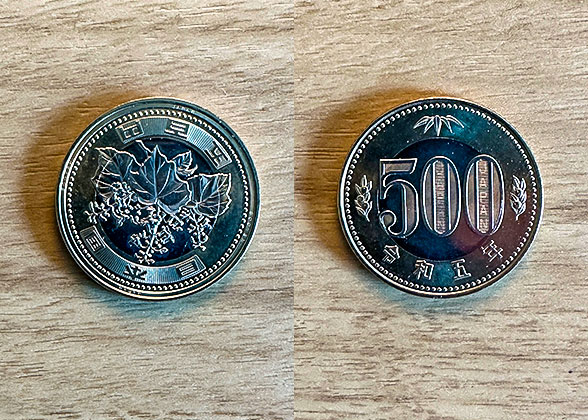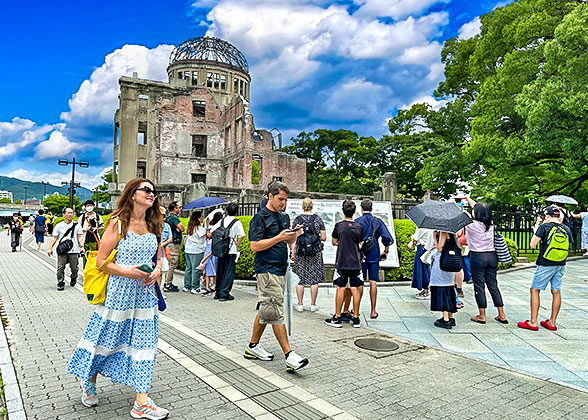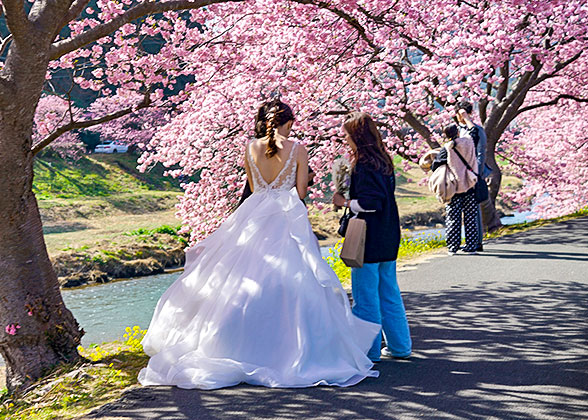- Do I Need a Visa?
- Visa-Free Travel
- How to Plan Your First Japan Trip
- How Long to Stay
- How to Spend One Week
- Cheapest Month to Visit
- Expensive Months to Visit
- Is There a Big Language Barrier
- Is It Safe to Travel in Japan
- How Much Does a Japan Trip Cost
- Payment Codes
- Money Exchange
- Currency in Japan
- 10 Things to Know Before Departure
- 15 Tips for First-Timers
- Top 6 Hiking Destinations
- WiFi & SIM Card
- Power Sockets
- Ultimate Guide for Hiking/Trekking
- Are Vaccines Needed?
- China’s Tourism VS Japan’s Tourism
- Do I Need to Tip
Currency in Japan – Japanese Yen

500 Yen Coins
|
Main Notes Used in Japan
The notes of 1,000 yen, 5,000 yen, and 10,000 yen are frequently used in Japan, while it’s reported that the newest series of notes are issued in July 2024. Although the new notes would be issued, the old notes could also be utilized over a period.Besides, the notes of 2,000 yen are not commonly used around the nation, so it’s not redesigned; it’s most likely to see a note of 2,000 yen in Okinawa probably.
Notes of 1,000 Yen:
The portrait of Noguchi Hideyo, a renowned medical scientist in the late 19th and early 20th century, is printed on the right side of the front.
At the back, there is the image of Mount Fuji, Lake Motosu-ko with cherry blossoms on the left side.
|
|
|
For the new notes of 1,000 yen, the figure on the front will be changed into Kitasato Shibasaburō, who was also a contemporaneous medical scientist and made a great contribution to medicines and medical education of Japan.
On the back, the famous Japanese ukiyo-e woodcut painting Under the Great Wave off Kanagawa of the series Fugaku sanjūrokkei (36 Views of Mt. Fuji) will replace the old pattern.
Notes of 5,000 Yen:
Higuchi Ichiyo, a highly-praised female poet and novelist in the late 19th century, is printed on the front.
The painting of irises, a part of the screen painting by Ogata Korin (17th century) is at the back.
|
|
|
New notes of 5,000 yen will enter circulation with a portrait of Tsuda Umeko (1864-1929 AD), who was a great educator in Meiji era, on the front and Japanese wisteria flowers at the back.
Notes of 10,000 Yen:
For the portrait on the front, it is Fukuzawa Yukichi, one of greatest writers, educators and ideologists in the 19th century.
On the reverse, there is the pattern of Phoenix Statue on the roof in Byodoin Temple, which was constructed in the middle of 9th century.
|
|
|
For the new pattern, the portrait will be replaced by that of Shibusawa Eiichi (1840-1931 AD), an active role as the samurai, politician and industrialist in Japan history.
The reverse side of new notes will be printed with Marunouchi Building of Tokyo Station.
Coins in Japan
Coins are often used likewise in Japan. The coins issued include those of 1 yen, 5 yen, 10 yen, 50 yen, 100 yen, and 500 yen.
|
|
|
|
Coins |
Materials |
Diameter |
Weight |
Patterns |
|
|
|
Front |
Back |
|||
|
1 yen |
Aluminum |
20mm |
1g |
A young tree |
Arabic numeral “1” |
|
5 yen |
Copper & zinc |
22mm |
3.75g |
Ears of rice, peaceful water & a toothed gear around the round hole |
Sprouting plants |
|
10 yen |
Copper; a little zinc & tin |
23.5mm |
4.5g |
the Phoenix Hall of Byodoin Temple, arabesques |
Withe of evergreen tree arabic numeral “10” |
|
50 yen |
Copper & nickel |
21mm |
4g |
Chrysanthemum flowers |
Arabic numeral “50” |
|
100 yen |
Copper & nickel |
22.6mm |
4.8g |
Cherry blossoms |
Arabic numeral “100” |
|
500 yen |
Copper, zinc gilded on the surface, nickel on the outer edge |
26.5mm |
7.1g |
Paulownia plant |
Bamboo leaves, citrus, “500” |
|
|
|
Is it possible to get counterfeit money in Japan?
There is no exception of counterfeit money in Japan, just like in other countries around the world. However, a low rate of counterfeit money is guaranteed there.For the high rate to use cashes in the country, the latest anti-fake technologies are utilized on Japanese currency, including but not limited to security stamps, watermark, sub-images, holographic laser images, intaglio printing and micro lettering. Due to the high technologies, there would be a very high cost to make counterfeit money, which makes counterfeit money a bad business in Japan.
On the other hand, the offenders to produce counterfeit money would be sentenced to imprisonment for three years at least or even the life imprisonment. Also, they would become the focus around the nation and be blamed vehemently by media and the public.
Friendly Tips:
Read More:
![]() An In-Depth Comparison between China’s Tourism and Japan’s Tourism
An In-Depth Comparison between China’s Tourism and Japan’s Tourism
You May Like
-
 7 Days Mini Group Tour with the Essence of Japan: Tokyo - Mt. Fuji - Kyoto - Nara - Osaka from USD2155
7 Days Mini Group Tour with the Essence of Japan: Tokyo - Mt. Fuji - Kyoto - Nara - Osaka from USD2155 -
 11 Days Mini Group: Tokyo - Hakone (Mt. Fuji) - Kyoto - Nara - Osaka - Hiroshima - Kanazawa - Shirakawa-go - Takayama - Tokyo from USD3554
11 Days Mini Group: Tokyo - Hakone (Mt. Fuji) - Kyoto - Nara - Osaka - Hiroshima - Kanazawa - Shirakawa-go - Takayama - Tokyo from USD3554 -
 10 Days Private Tour of Tokyo - Mt. Fuji - Nagoya - Takayama - Shirakawa-go - Kanazawa - Kyoto - Nara - Hiroshima - Osaka from USD3809
10 Days Private Tour of Tokyo - Mt. Fuji - Nagoya - Takayama - Shirakawa-go - Kanazawa - Kyoto - Nara - Hiroshima - Osaka from USD3809


